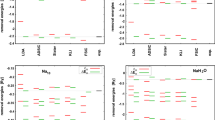Abstract
The charge, spin distribution and dipole moments of the open shell molecules PF and PCl have been analyzed using two variants of the Hirshfeld partitioning of the electronic density. In the HI or iterative Hirshfeld approach, one keeps the number of electrons on a given atom in the molecule and proto molecule equal and does not constrain the spin distribution in any way. In the spin-adapted approach, one constrains both the charges and spins on the in situ and proatoms to be equal. We find that while allowing for both spin and charge equalization results in a spin distribution that is different from that of the conventional HI method, the behavior of the atomic spin populations as a function of internuclear separation is similar. Both methods predict that as the bond is formed, the halogen gains α and looses β electrons with the converse for P. These electron shifts are further broken down into their σ and π components and we find that while the α electrons gained by the halogen are essentially all in the σ system, they come from both the σ and π system of P. The β electrons gained by P occupy both σ and π densities, but come essentially from the π system on the halogen. The dipole moment curves are partitioned into their α and β components and showing that the dipole due to the σ spin density has the polarity P + X − while that due to the β spin density has the polarity P − X +, while the net dipole polarity at equilibrium is P + X −, consistent with the spin-dependent charge shifts described above.
















Similar content being viewed by others
References
Harrison JF (2009) J Chem Phys 131:044117
Hirshfeld FL (1977) Theor Chim Acta 44:129
Bultinck P, VanAlsenoy C, Ayers PW, Carbo-Dorca R (2007) J Chem Phys 126:144111
Geldof D, Krishtal A, Blockhuys F, Van Asenoy C (2011) J Chem Theory Comput 7:1328
Douglas AE, Frackowiak M (1962) Can J Phys 40:832
Minowa T, Saito S, Hirota E (1985) J Chem Phys 83:4939
Kanamori H, Yamada C, Butler JE, Kawaguchi K, Hirota E (1985) J Chem Phys 83:4945
Saito S, Endo Y, Hirota E (1985) J Chem Phys 82:2947
O’Hare PAG, Wahl AC (1971) J Chem Phys 54:4563
O’Hare PAG (1973) J Chem Phys 59:3842
Nguyen MT (1986) Mol Phys 59:547
Peterson KA, Woods C (1990) J Chem Phys 93:1876
Latifzadeh L, Balasubramanian K (1995) Chem Phys Lett 243:243
Papakondylis A, Mavridis A, Metropoulos A (1995) J Phys Chem 99:10759
Dunning TH Jr (1989) J Chem Phys 90:1007
Woon DE, Dunning TH Jr (1993) J Chem Phys 98:1358
Bravo R, Machado BC (1999) Chem Phys Lett 307:511
de Brouckere G (2000) Chem Phys 262:229
da Silva-Neto AG, Roberto-Neto O, Ornellas FR, Machado FBC (2004) Chem Phys Lett 395:239
Dunning TH Jr, Peterson KA, Wilson AK (2001) J Chem Phys 114:9244
Kendall RH, Dunning TH Jr, Harrison RJ (1992) J Chem Phys 96:6796
Werner HJ, Knowles PJ, Almof J, Amos RD, Deegan MJO, Elbert ST, Hampel C, Meyer W, Peterson WK, Pitzer R, Stone AJ, Taylor PR, Lindh R, Mura ME, Thorsteinsson T Molpro, A package of ab initio programs
Davidson ER, Chakravorty S (1992) Theor Chim Acta 83:319
Parr RG, Ayers PW, Nalewajski RF (2005) J Phys Chem A 109:3957
Kulback S (1977) Information theory and statistics. Dover, Mineola
Nalewajski RF, Parr RG (2000) Proc Natl Acad Sci 97:8879
Ayers PW (2000) J Chem Phys 113:10886
Martin JML, Bauschlicher CW Jr, Ricca A (2001) Comput Phys Commun 133:189
Abramowitz M, Stegun IA (1970) Handbook of mathematical functions. Dover Publications Inc, New York
Author information
Authors and Affiliations
Corresponding author
Additional information
Dedicated to the memory of Professor Isaiah Shavitt and published as part of the special collection of articles celebrating his many contributions.
Rights and permissions
About this article
Cite this article
Harrison, J.F. A Hirshfeld interpretation of the charge, spin distribution and polarity of the dipole moment of the open shell \( \left( {^{3} \Sigma^{ - } } \right) \) phosphorus halides: PF and PCl. Theor Chem Acc 133, 1486 (2014). https://doi.org/10.1007/s00214-014-1486-5
Received:
Accepted:
Published:
DOI: https://doi.org/10.1007/s00214-014-1486-5



